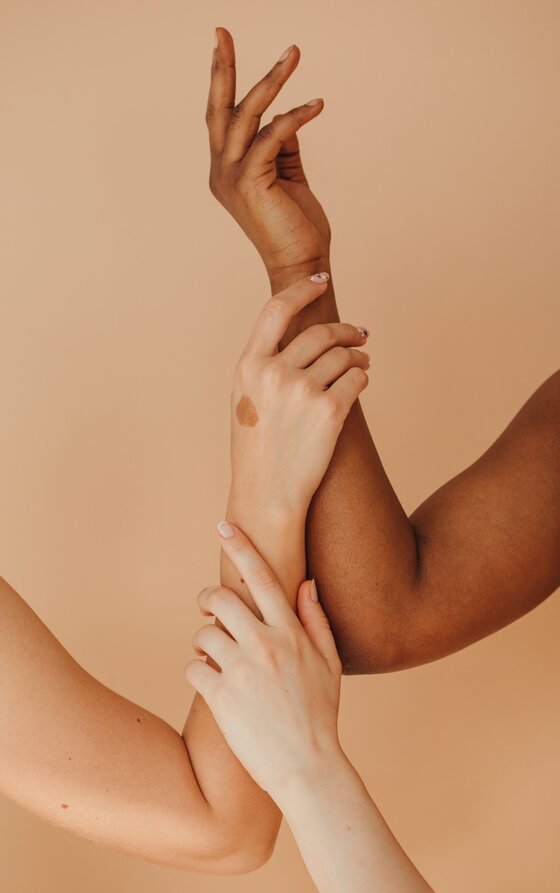
What Is Embodiment & How Can We Use It For Self-Care?
“In a world that is constantly objectifying [bodies]…to be embodied is a political act.”
Embodiment has become something of a buzzword in the past few years. You’ve likely heard the term tossed around in wellness communities, often alongside mindfulness, and the two are similar in that they both invite us to focus on the present moment.
But while mindfulness focuses on slowing down to become conscious of the world around us, embodiment is specific to our physical nature. Mainly, it asks us to remember that our bodies and minds are not separate but connected.
Understanding this connection isn’t always easy though, especially in the Western world where we’re accustomed to ignoring our bodies’ needs in the name of productivity. Or, alternatively, suppressing and controlling them.
“[Embodiment] asks us to remember that our bodies and minds are not separate but connected.”
I remember when I was in college and had a short stint with running, for example. Every day on that track, no matter if my body was exhausted or injured, I laced up and recited that tired phrase, “mind over matter.” I believed that I needed to listen to my brain and not my body to achieve my running goals. I didn’t understand how the two were actually connected and spoke to one another.
I’ve experienced this disconnect between my mind and body in other periods of my life, too—like in graduate school, when I attempted to survive on salt and vinegar chips and coffee alone. Or when, as a young girl in church, I was taught that my body’s sexual desires needed to be suppressed until marriage.
All of these are examples of disembodiment, and also mind-body dualism—i.e., the belief that our minds and bodies exist separate of one another. First though, let’s take a few steps back through history—to 1596 France—so that we can better understand why we’re talking about embodiment at all. Enter: René Descartes, the French philosopher credited for creating mind-body dualism in Western philosophy.
The History Of Embodiment
Mind-body dualism claims that physical matter is distinct, and a person’s thoughts and emotions are separate from their physical self. According to Descartes, “The nature of the mind (that is, a thinking, non-extended thing) is completely different from that of the body (that is, an extended, non-thinking thing), and therefore it is possible for one to exist without the other.”
It wasn’t only Descartes who believed the body was separate from the mind. These schools of thinking go as far back as the 5th century BC to Plato, who also argued for mind-body dualism. A few hundred years later, Augustine‘s work became influential in Christian and Catholic religion, as he believed the body was “sinful” and needed to be controlled.
These philosophies have defined much of how we view our bodies in the West today. And they are partly responsible for why we’re having a conversation about embodiment to begin with. For many of us, mind-body dualism has influenced our entire lives—from Western medicine to how we process stress and anxiety to how we “check out” with technology.
“Mind-body dualism has influenced our entire lives—from Western medicine to how we process stress and anxiety to how we ‘check out’ with technology.”
“When I enter into a digital ‘space’, my body as good as disappears,” writes Dan Nixon in The Body As A Mediator. “…This disembodied picture aligns all too well with how it actually feels to be totally absorbed in some ‘content’ on my phone for 30 minutes at a stretch.”
Trauma, as well as religious ideologies, can also influence how we feel about our bodies. If we’ve experienced harm, we might not feel safe in our physical selves. And if we were raised with religious ideologies that taught us our bodies were “dirty” or “sinful,” we may also struggle to come into our physical selves fully.
Thankfully, philosophers and psychologists have poked holes in these theories, including Maurice Merleau-Ponty, a 20th-century French philosopher. He claimed that the world can’t be experienced without the body and that the self and reality comprise each other. “We have a body, but we also are a body. There is no me without my body,” he said.
According to Merleau-Ponty, our body is very much a part of our existence and who we are, yet it’s often been reduced and objectified so that we feel disconnected from it. Embodiment teaches that our bodies are not simply a house for our thoughts and emotions; they are a part of us. Using this theory, we can bridge the mind-body gap and realize everything works in harmony to help us find balance and grounded living.
We can return to ourselves—our physical selves, that is—and connect to our bodies again, seeing them as an extension of who we are, no matter how they look or function.
How To Practice Embodiment For Self-Care
How then do we reclaim our bodies and practice embodiment, especially as a form of self-care?
1. Taking up space.
If you’ve always been told to make yourself smaller or invisible, this can feel especially scary as disembodiment is something many of us practice subconsciously, since we’ve learned we’re not allowed to show up in our complete form. Disembodiment can also be a survival mechanism when we’ve experienced physical trauma or harm. We leave our bodies because our bodies don’t feel safe.
“Take small notes about how you feel in your physical form.”
But we can practice returning to our bodies by first becoming conscious of how we take up space in a room. Notice how you feel when you walk into a space, pay attention to the way your limbs sway or how your bottom feels in a chair. Can you feel the wind on your face? Does your body feel heavy, lightweight? Take small notes about how you feel in your physical form—even if that feeling is uncomfortable or scary. There is no judgment or goal here.
2. Plant your feet.
Practice relaxing your body when engaging in daily tasks. Even breathing deeply is something many of us forget to do. While doing the dishes, driving in your car, or lying in bed, relax your body and take deep breaths. Many of us hold tension in our shoulders, so notice if you are hunching yourself and do a few shoulder rolls.
Also, plant your feet while sitting. It may sound simple, but having both feet placed on the ground can literally be—well—grounding. This can work while standing too, by noticing how your feet are connected to the floor and supporting your body. And if you’re unable to stand, you can try this practice with your bottom, noticing how your weight feels in your chair. By simply feeling gravity’s pull, we can feel more embodied and even more confident as we speak and move throughout our day.
3. Shift your language.
“Remember that our bodies are beautiful and strong, even if they may look different or function differently than we expect them to.”
We can also practice embodiment by simply addressing our bodies as part of us and shifting our language to talk about them as part of who we are. So much of our value is placed on exerting our bodies and moving them in challenging ways—but also remember that our bodies are beautiful and strong, even if they may look different or function differently than we expect them to.
I went through some embodiment coaching a few years back, and one of the recommended practices was giving my body a name and pronoun. So instead of always talking about my body like it’s an object, I sometimes say “she” or use the name I chose. This helps me remember that my body is an extension of myself, and “she” can communicate with me.
4. Learn to listen.
Remember the story about me running in college? I didn’t know how to work with my body, only against it. But as I’ve learned more about embodiment, I’ve seen how I can listen to and let my body take the lead.
For me, this looks like regular body scans. It also means listening to my body when “she” has something to say. I’ve long ditched the phrase “mind over matter” and instead ask questions, like: “Does this feel good?” “Would I like to run a bit farther, a bit faster?” “What is my body saying to me at this moment?”
Our bodies speak to us, and they have a lot to say. They can communicate with us about illness or trauma. And they can also teach us how to take better care of ourselves. But first, we have to learn to listen.
5. Seek out movement and sensory experiences.
To reconnect with our bodies, we can practice daily movement and engage our senses. This doesn’t have to be exertion or strenuous exercise, but rather simple practices like walking, stretching, or even sweating can help us remember our physicality.
Additionally, small acts like putting on lotion (slowly and with intention) or giving ourselves a hand massage can reconnect us to our bodies. We can engage our senses through smell and taste, too. It sounds so simple, but eating slowly or with your eyes closed is an excellent way to experience taste and, ultimately, embodiment.
“When we become embodied, we can live more grounded and conscious lives—in mind, body, and spirit.”
I hope these practices can help you find the connection between your mind and your body once again. Remember that each is beautiful on their own, but also when working together. When we become embodied, we can live more grounded and conscious lives—in mind, body, and spirit. I wish this for myself, and also for you.
How do you practice embodied living? If you have any tips or suggestions, I’d love to hear them in the comments below. x
Kayti Christian (she/her) is a Senior Editor at The Good Trade. She has a Master’s in Nonfiction Writing from the University of London and is the creator of Feelings Not Aside, a newsletter for enneagram 4s and other sensitive-identifying people. Outside of writing, she loves hiking, reading memoir, and the Oxford comma.





